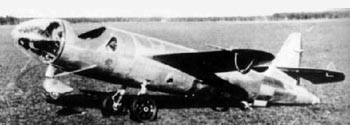Heinkel He 176
|
|
| Heinkel He 176 | ||
|---|---|---|
 | ||
| Description | ||
| Role | Experimental prototype | |
| Crew | one, pilot | |
| Dimensions | ||
| Length | 5.2 m | 17 ft 1 in |
| Wingspan | 5.0 m | 16 ft 5 in |
| Height | 1.5 m | 4 ft 11 in |
| Wing area | 5.4 m² | 58 ft² |
| Weights | ||
| Empty | 900 kg | 1,980 lb |
| Loaded | 1,620 kg | 3,570 lb |
| Maximum take-off | ||
| Powerplant | ||
| Engine | HWK RI-203 | |
| PThrust | 5.9 kN | 1,300 lbf |
| Performance | ||
| Maximum speed theoretical | 750 km/h | 470 mph |
| Maximum speed attained | 345 km/h | 215 mph |
| Range theoretical | 95 km | 60 miles |
| Endurance attained | 50 s | |
| Ceiling theoretical | 9,000 m | 29,500 ft |
| Rate of Climb | 60.6 m/s | 199 ft/s |
The Heinkel He 176 was the world’s first aircraft to be propelled solely by a liquid-fuelled rocket, making its first powered flight on July 20 1939 with Erich Warsitz at the controls. It was a private venture by the Heinkel company in accordance with director Ernst Heinkel's emphasis on developing technology for high-speed flight. The performance of the He 176 was not spectacular, but it did provide "proof of concept" for rocket propulsion.
During the 1920s, German daredevils had experimented with using solid-fuel rockets to propel cars, motorcycles, railway carriages, snow sleds, and, by 1929, aircraft such as Alexander Lippisch’s Ente and Fritz von Opel’s RAK.1. Solid-fuel rockets, however, have major disadvantages when used for aircraft propulsion, as their thrust cannot be regulated, and the engines cannot be shut down once fired.
In the late 1930s, Wernher von Braun's rocketry team working at Peenemünde investigated installing liquid-fuelled rockets in aircraft. Heinkel enthusiastically supported their efforts, supplying a Heinkel He 72 and later two Heinkel He 112s for the experiments. In Spring 1937, one of these latter aircraft was flown with its piston engine shut down during flight, at which time it was propelled by rocket power alone. At the same time, Hellmuth Walter's experiments into Hydrogen peroxide-based rockets were leading towards light and simple rockets that appeared well-suited for aircraft installation.
The He 176 was built to utilise one of the new Walter engines. It was a tiny, simple aircraft, built almost entirely out of wood and lacking even an enclosed canopy. It had a conventional, fixed, tricycle undercarriage, but relied on the weight of the pilot to actually rest on its wheels. Empty, the tail of the plane rested on the ground.
Heinkel demonstrated the aircraft to the RLM, but official disinterest led to the abandonment of the company's rocket propulsion programme. The He 176 was placed in the Deutsches Technikmuseum ("German Technical Museum") in Berlin, where it was destroyed in an air raid during World War II.
Prior to the cancellation of the programme, plans had been drawn up for a more sophisticated rocket-plane, still designated He 176. This was never constructed, but because it bore the same designation as the aircraft that was actually flown, many books and websites mistakenly publish pictures of it to illustrate its earlier namesake.
Germany did eventually fly an operational rocket-propelled fighter, the Me 163, but this was made by the competing Messerschmitt firm, using an engine that was a further development of the one that powered the He 176.
Missing image
He_176_V2.jpg
Image:He_176_V2.jpg
Specifications (variant described)
General characteristics
- Crew:
- Capacity:
- Length: m ( ft)
- Wingspan: m ( ft)
- Height: m ( ft)
- Wing area: m² ( ft²)
- Empty: kg ( lb)
- Loaded: kg ( lb)
- Maximum takeoff: kg ( lb)
- Powerplant: Engine type(s), kN (lbf) thrust
Performance
- Maximum speed: km/h ( mph)
- Range: km ( miles)
- Service ceiling: m ( ft)
- Rate of climb: m/min ( ft/min)
- Wing loading: kg/m² ( lb/ft²)
- Thrust/weight:
| Related content | |
|---|---|
| Related development | |
| Similar aircraft | |
| Designation series |
He 170 - He 172 - Bloch M.B.175 - He 176 - He 177 - He 178 - Bü 180 |
| Related lists | |
|
Lists of Aircraft | Aircraft manufacturers | Aircraft engines | Aircraft engine manufacturers Airports | Airlines | Air forces | Aircraft weapons | Missiles | Timeline of aviation |
